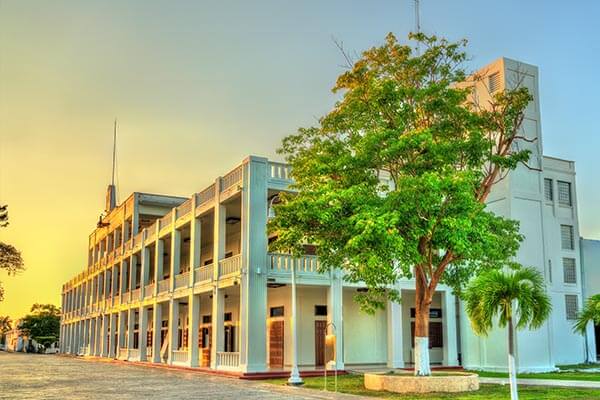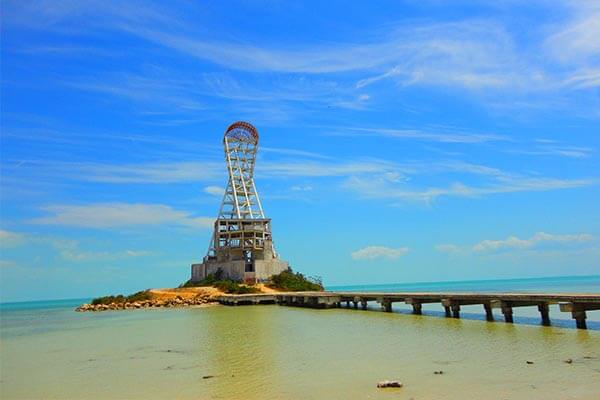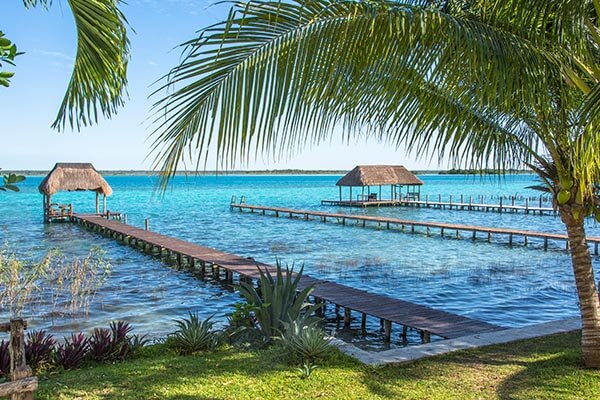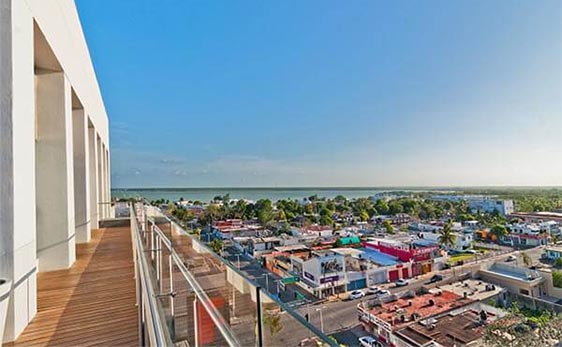Chetumal, Mexico
Written by Don Murray
The eastern coast of Mexico, along the shores of the Yucatan Peninsula, borders the warm, turquoise-green Caribbean Sea. There is a particularly well-known stretch that runs from Cancun down to Tulum and includes the popular destinations of Puerto Morelos, Playa del Carmen, Akumal, and Tulum. This well-known stretch is branded the Riviera Maya and its famous sugar sand beaches are the most popular vacation destination in the Caribbean basin. But south of the Riviera Maya, where the Costa Maya ends at the border with Belize, there is Chetumal, something completely different.
Chetumal may be the least-known city along Mexico’s Caribbean coast (to tourists and prospective expats) but is probably the most important. Chetumal, on the southeast tip of the Yucatan Peninsula, is the Capital of the Yucatan state of Quintana Roo. It is the seat of government power for the state and is, without a doubt, the least effected by tourism or expat influence of all the cities along Mexico’s Caribbean coast. While sharing the same stunning Caribbean Sea, Chetumal is not overrun with tourists like its northern cousins on the Riviera Maya and has a small expat population. It is a developing city of some 150,000 residents and has reason to be proud.
Along with a host of government office buildings, Chetumal also has an International Airport and a large music school, drawing students from across Mexico. It also boasts a large university and numerous parks, monuments, five museums, a junior symphony orchestra, and a huge shopping mall (Plaza de las Americas with a modern cinema, bustling food court, large department stores, and ample parking).
Chetumal is a vibrant city without a touristy vibe. You won’t find large all-inclusive resorts here or a loud, booming nightlife. Chetumal is the totally functional, polite southern cousin to its bawdy northern neighbors and shows no indication of wanting to compete.
Bordering the country of Belize, Chetumal enjoys some economic stimulation from those Belizeans who cross the border to take advantage of shopping and medical care.
The first thing one notices about Chetumal is the general cleanliness of the city. Parks and public roadways are kept clean, without the debris often seen elsewhere. The distribution of monuments and statues throughout the city add to the overall beauty and feeling that this city is well managed and the residents have a sense of pride.
The weather is Caribbean, with a mean average temperature of 82 F and the record high just touching 100 F. That also means keeping a close eye on the weather during hurricane season, although Chetumal is a bit too far south to generate much concern.
Sitting on the picturesque Bay of Chetumal with direct access to the Caribbean Sea, there is an active sport fishery in the bay and a fleet of charter boats stands ready to shuttle anglers to their respective targets.
Retire in Chetumal

Mexico has a couple of simple, straightforward visas for retirees; the first is a Temporary Resident Visa and the second is a Permanent Resident Visa. Both allow full-time residency in Mexico but there are some significant differences such as income requirements, employment legalities, and automobile importation.
Visitors spending less than 180 days in Mexico need only possess a valid passport. No visa application required. That allows all those snowbirds to make repeat, annual visits without worrying about a visa, as long as they do not exceed the 180-day limit. If you wish to remain longer than 180 days, you must apply for a visa.
Begin your visa quest at the Mexican Consulate in your home state or any Mexican Consulate in the States. There, the consulate officer will review your completed application; verify your income based on the documents you provide, review a nominal number of other documents, and your completed application. After a short interview, if approved, you’ll likely depart with your residency visa affixed to the inside of your passport, that very day or a day or two later.
You will complete your residency requirements, once you enter Mexico, by making an appointment with the immigration service and obtaining your residency card.
All legal residents over the age of 60 qualify for a discount card from INAPAM (Instituto Nacional para las Personas Adultas Mayores) facilitating discounts on a wide variety of goods and services.
Those wishing to retire in or live in Chetumal should possess functional (not perfect) Spanish language skills as English is rarely spoken or heard.
Medical Care in Chetumal
In addition to having several clinics that cater to everyday medical needs, Chetumal also has three major hospitals. The General Hospital Chetumal is a large, modern hospital with 24-hour emergency services and provides all levels of medical care. The ISSTE Hospital (Institute for Social Security) hospital provides the care for all the employed workers under the national healthcare plan and is also open to others. It also offers 24-hour emergency care. And finally, the Naval Hospital is available for limited services to civilians.
At the time of this writing, Mexico has just undergone a major change in their national healthcare program. While details are still emerging, the new system guarantees free or very low-cost services to all residents, including legal expat residents.
Lifestyle in Chetumal

In many ways, Chetumal resembles a medium-size university town in the U.S. There are ample restaurants and shopping with students shuttling across town for classes. The music school offers many concerts for the public and the junior symphony posts a regular schedule, as well. The predominant business of the city is the State government so it is common to see professionally dressed men and women on their way, to and from their government jobs. What you won’t see wandering the streets are legions of tourists in swimwear and flip-flops, hailing taxis and waiting for buses, as is common on the Riviera Maya.
Public transportation is cheap and readily available with taxis being a primary resource. And for those who drive themselves, I found local traffic to be very manageable, far less dense and troublesome than the Riviera Maya.
Chetumal is a conservative and very safe city where one may easily consider raising a family or, retiring.
Things to Do in Chetumal

The Bay of Chetumal offers great boating and fishing but allows few options for beachgoers. For those who must immerse themselves in saltwater and wiggle their toes in the sand, Calderitas is only a short 15 minute drive away. Drive a bit further and you can enjoy Xcalak and Mahahual with ample beach space and a handful of beach clubs. Of course, there is always the spectacular (and crowded) Tulum if you want to go full tourist. Or, you might enjoy the gleaming fresh water of Bacalar, the Lake of Seven Colors, which is much closer.
The newly constructed and spectacular architecture of the Museum of Mayan Culture is a must see. It sits right on the bay and is definitely worth several visits. Constructed on three levels to represent the three levels of the Mayab (Maya world), the main level represents the current time period showing the cultural history with large amounts of artifacts and dioramas. The upper level represents the Maya heavens and the lower level represents the dark underworld…complete with scary soundtrack. Do not miss this museum if you have an interest in Maya culture. The recorded sounds for each level actually add an attraction-like feel, uncommon for a museum. The jungle sounds are quite realistic.
As Chetumal is on the border with Belize, trips across the border can provide a glimpse of life there. But the real fun happens when you take a shuttle ferry to the Belizean island of Ambergris Caye. This island is a total tourist hotspot with diving, snorkeling, and a vibrant beach and nightlife.
Cost of Living in Chetumal
Being an entirely Mexican city with few cultural incursions, and an economy not reliant upon tourist dollars and the oft-inflated costs associated with tourist destinations, Chetumal’s economy reflects that status with overall lower prices. The cost of living is a fraction of what it takes to live anywhere in the States, making retirement in Chetumal an attractive economic alternative.
Like most places in Mexico, finding a place to live is a boots-on-the ground endeavor. You must be there and make contact with the people in the area to find what is available. A proven strategy is to take a small, short-term place for a month or two until you can familiarize yourself with the area and the market. The one thing to keep in mind is that most available properties will not be listed on the internet. That said, here is an estimate of monthly costs for a couple.
The restaurants are very reasonable, where a $25 dinner for two with a drink is standard. A $5 Mexican dish is easily obtained just about everywhere. As always, your individual budget will vary depending upon the choices you make.
| Expenses | U.S. $ |
| Rent | $450 to $650 |
| Utilities | $60 |
| Groceries | $325 |
| Entertainment | $250 |
| Housekeeping | $100 |
| Medical | $150 |
| Transportation (car, gas, insurance) | $100 |
| Transportation (public) | $45 |
| Total | $1,480 to $1,680 |

